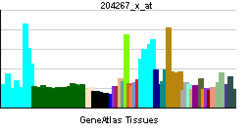PKMYT1
Membrane-associated tyrosine- and threonine-specific cdc2-inhibitory kinase is an enzyme that in humans is encoded by the PKMYT1 gene.[1][2][3]
The protein encoded by this gene is a member of the serine/threonine protein kinase family. This kinase preferentially phosphorylates and inactivates cell division cycle 2 protein (CDC2), and thus negatively regulates cell cycle G2/M transition. This kinase is associated with the membrane throughout the cell cycle. Its activity is highly regulated during the cell cycle. Protein kinases AKT1/PKB and PLK (Polo-like kinase) have been shown to phosphorylate and regulate the activity of this kinase. Alternatively spliced transcript variants encoding distinct isoforms have been reported.[3]
Interactions
PKMYT1 has been shown to interact with PIN1[4] and STEAP3.[2]
References
- ↑ Liu F, Stanton JJ, Wu Z, Piwnica-Worms H (Feb 1997). "The human Myt1 kinase preferentially phosphorylates Cdc2 on threonine 14 and localizes to the endoplasmic reticulum and Golgi complex". Mol Cell Biol 17 (2): 571–83. PMC 231782. PMID 9001210.
- ↑ 2.0 2.1 Passer BJ, Nancy-Portebois V, Amzallag N, Prieur S, Cans C, Roborel de Climens A, Fiucci G, Bouvard V, Tuynder M, Susini L, Morchoisne S, Crible V, Lespagnol A, Dausset J, Oren M, Amson R, Telerman A (Mar 2003). "The p53-inducible TSAP6 gene product regulates apoptosis and the cell cycle and interacts with Nix and the Myt1 kinase". Proc Natl Acad Sci U S A 100 (5): 2284–9. doi:10.1073/pnas.0530298100. PMC 151332. PMID 12606722.
- ↑ 3.0 3.1 "Entrez Gene: PKMYT1 protein kinase, membrane associated tyrosine/threonine 1".
- ↑ Shen, M; Stukenberg P T; Kirschner M W; Lu K P (Mar 1998). "The essential mitotic peptidyl-prolyl isomerase Pin1 binds and regulates mitosis-specific phosphoproteins". Genes Dev. (UNITED STATES) 12 (5): 706–20. doi:10.1101/gad.12.5.706. ISSN 0890-9369. PMC 316589. PMID 9499405.
Further reading
- Booher RN, Holman PS, Fattaey A (1997). "Human Myt1 is a cell cycle-regulated kinase that inhibits Cdc2 but not Cdk2 activity.". J. Biol. Chem. 272 (35): 22300–6. doi:10.1074/jbc.272.35.22300. PMID 9268380.
- Shen M, Stukenberg PT, Kirschner MW, Lu KP (1998). "The essential mitotic peptidyl-prolyl isomerase Pin1 binds and regulates mitosis-specific phosphoproteins.". Genes Dev. 12 (5): 706–20. doi:10.1101/gad.12.5.706. PMC 316589. PMID 9499405.
- Liu F, Rothblum-Oviatt C, Ryan CE, Piwnica-Worms H (1999). "Overproduction of human Myt1 kinase induces a G2 cell cycle delay by interfering with the intracellular trafficking of Cdc2-cyclin B1 complexes.". Mol. Cell. Biol. 19 (7): 5113–23. PMC 84354. PMID 10373560.
- Wells NJ, Watanabe N, Tokusumi T et al. (1999). "The C-terminal domain of the Cdc2 inhibitory kinase Myt1 interacts with Cdc2 complexes and is required for inhibition of G(2)/M progression.". J. Cell. Sci. 112 (19): 3361–71. PMID 10504341.
- Pathan N, Aime-Sempe C, Kitada S et al. (2001). "Microtubule-targeting drugs induce Bcl-2 phosphorylation and association with Pin1.". Neoplasia 3 (1): 70–9. doi:10.1038/sj/neo/7900131. PMC 1505024. PMID 11326318.
- Okumura E, Fukuhara T, Yoshida H et al. (2002). "Akt inhibits Myt1 in the signalling pathway that leads to meiotic G2/M-phase transition.". Nat. Cell Biol. 4 (2): 111–6. doi:10.1038/ncb741. PMID 11802161.
- Strausberg RL, Feingold EA, Grouse LH et al. (2003). "Generation and initial analysis of more than 15,000 full-length human and mouse cDNA sequences.". Proc. Natl. Acad. Sci. U.S.A. 99 (26): 16899–903. doi:10.1073/pnas.242603899. PMC 139241. PMID 12477932.
- Nakajima H, Toyoshima-Morimoto F, Taniguchi E, Nishida E (2003). "Identification of a consensus motif for Plk (Polo-like kinase) phosphorylation reveals Myt1 as a Plk1 substrate.". J. Biol. Chem. 278 (28): 25277–80. doi:10.1074/jbc.C300126200. PMID 12738781.
- Ota T, Suzuki Y, Nishikawa T et al. (2004). "Complete sequencing and characterization of 21,243 full-length human cDNAs.". Nat. Genet. 36 (1): 40–5. doi:10.1038/ng1285. PMID 14702039.
- Dai X, Yamasaki K, Yang L et al. (2004). "Keratinocyte G2/M growth arrest by 1,25-dihydroxyvitamin D3 is caused by Cdc2 phosphorylation through Wee1 and Myt1 regulation.". J. Invest. Dermatol. 122 (6): 1356–64. doi:10.1111/j.0022-202X.2004.22522.x. PMID 15175024.
- Martin J, Han C, Gordon LA et al. (2005). "The sequence and analysis of duplication-rich human chromosome 16.". Nature 432 (7020): 988–94. doi:10.1038/nature03187. PMID 15616553.
- Bryan BA, Dyson OF, Akula SM (2006). "Identifying cellular genes crucial for the reactivation of Kaposi's sarcoma-associated herpesvirus latency.". J. Gen. Virol. 87 (Pt 3): 519–29. doi:10.1099/vir.0.81603-0. PMID 16476973.
- Nousiainen M, Silljé HH, Sauer G et al. (2006). "Phosphoproteome analysis of the human mitotic spindle.". Proc. Natl. Acad. Sci. U.S.A. 103 (14): 5391–6. doi:10.1073/pnas.0507066103. PMC 1459365. PMID 16565220.
- Wissing J, Jänsch L, Nimtz M et al. (2007). "Proteomics analysis of protein kinases by target class-selective prefractionation and tandem mass spectrometry.". Mol. Cell Proteomics 6 (3): 537–47. doi:10.1074/mcp.T600062-MCP200. PMID 17192257.
